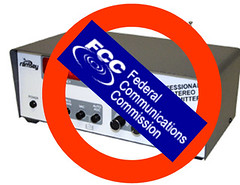Andrew points to the RHZ Amateur Radio Network, which
is a participatory experiment aiming to create the possibility of a legal, publicly owned and operated broadcast radio that is built like a peer to peer network.
The idea is to use legal unlicensed low-power AM transmitters operating at Part 15 levels — under 100 milliwatts — to set up a radio network that pulls its content off a central repository.
It’s interesting and seems like it may be a worthwhile project. But for all the project’s rhetoric, it’s not that innovative. Pirate stations have been contributing to and pulling from free program sharing sites like radio4all and radio.indymedia for quite some time.
What’s a little disappointing is that RHZ doesn’t really provide much tech info for getting a transmitter running — just links to a $39 and a $400 transmitter. But AM is more difficult to get running efficiently than FM, primarily because its wavelengths are so much longer, requiring huge antennas.
Kyle Drake, who I met at Radio Access Democracy, is doing some pioneering engineering work to help make legal low-power AM broadasting simpler and more effective. There is already a community of broadcasters who have been doing low-power AM for a while using a variety of transmitters and antenna designs. They can be found at the Community Radio USA message board.
I get the sense that the guy behind RHZ didn’t really research low-power AM much before diving in with his cheap transmitter. Otherwise, I’d think he would have reached out to the existing community and also have some better tech documentation for people who want to get involved.
If anything, perhaps what the RHZ project adds is an element of coordination between stations, along with the ‘net hipster cred of integrating the peer-to-peer concept and Creative Commons licensing.
I don’t really mean to be so cynical and critical — this may be a project that takes off, though at 6 weeks in that still remains to be seen.
I’ve been studying low-power and unlicensed broadcasting for almost ten years now, and I’ve seen dozens of projects like this get announced and hyped only to see almost all fail. And the reason why I think they fail is because the people behind them often are unaware of similar efforts that came before, or that are going on simultaneously. They miss out on the collective experience and expertise that is there to be shared.
The Radio Re-Volt project I think is an example of one that worked because it tapped the well of legal unlicensed low-power FM knowledge and expertise. It’s goals were different than RHZ’s, but like RHZ it seems like Re-Volt was driven more by artistic and community goals rather than geeky tech ones. Yet Re-Volt succeeded in putting hundereds of transmitters into the hands of average folks because they chose to draw on both the theory and experience of innovators like 2005 workshop schedule, which includes their low-power television session. While this may be the start of a new pirate TV movement in the US, pirate TV has been alive in Italy for several years and was used in Eastern Europe during Soviet times.
Demand Media directed me to a new short documentary on the Italian Telestreet movement. This video, which you can download at archive.org, takes you on a tour of an actual pirate TV studio.
Another longer documentary, called Ethereal Shadow Archipelago, can be watched at freespeech.org. This video puts the pirate TV into the larger context of Italian media consolidation, which is more severe and disturbing than even the US context, given that Prime Minister Berlusconi is also the nation’s biggest media baron. It would be as if Fox owner Rupert Murdoch were the US president.
It’s interesting that contemporary pirate TV seems to have taken root in Italy before the US. Tetsuo Kogawa, the father of mini-FM radio in Japan, which is the inspiration for micropower broadcasting in the US, found his own inspiration with the micro-radio stations used by the Italian Autonomia movement in the 1970s.
The piqueteros movement in Argentina has also been utilizing pirate TV, as seen in the documentary TV Piquetera.
As I mentioned before, the spread of pirate TV in the US may be limited by the dwindling number of people relying on over-the-air broadcast TV, although that population is arguably poorer and more in need of radical information.
Still, I think it’s worth trying. And perhaps something can be learned from the Italian and Argentine experience, both in terms of tech and tactics.
Live pirate broadcast of streaming radio reports from the streets have been very useful in actions from the WTO in 1999 to the RNC protests in New York City this past Aug.
Just imagine if it were possible to have a TV broadcast of live video of riot cops indiscriminately rounding up people on the streets during a major protest action. Or, one might even broadcast a live camera from the top of a tall building, giving an aerial view of protest zones. Then, just as protesters often keep a radio handy to hear reports from micropower stations, they could also arm themselves with mini portable TVs for a visual report.
Sure, we might soon see the ability to stream live video over Wi-Fi to enabled PDAs or cell phones. But can you buy a playback device on eBay for less than $20?
There are still many advantages to broadcast TV that is not tethered to a cable, internet, laptop or a satellite dish.”>Tetsuo Kogawa.
